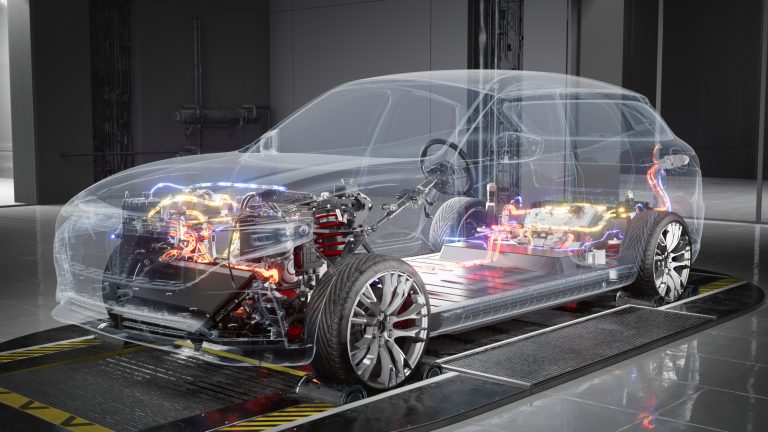
Innovations for the future: The development of safe batteries for electric vehicles
Increasingly powerful battery systems also require new approaches to improve the safety and service life of batteries. But what are the most important measures that a manufacturer can take? We present these following from the perspective of a battery manufacturer.
The thermal runaway of battery cells in a battery system, also known as thermal runaway (TR), is practically the biggest battery accident that can be assumed. TR describes a chain reaction in which the cell temperature rises rapidly to up to 1,300° C. The causes can be mechanical damage, internal cell damage or overheating.
The consequences are serious: hot gas and glowing particles form inside the battery pack, and fire may also cause a rise in temperature in other cells and components. If this thermal event of the TR spreads to neighboring cells, this is referred to as thermal propagation (TP).
To reduce the risk of such an unwanted reaction, various measures can be taken, such as the use of less reactive chemistry (lithium iron phosphate) or, in the case of more potent chemistry such as lithium nickel manganese cobalt oxide (NMC811), an appropriate design.
Farasis Energy now produces cells with very high energy densities of up to 330 Wh/kg. Figure 1 shows where the Farasis Energy P73 and P79 cells stand in comparison with the competition. The overview from Batemo, a company that tests cells and develops models, classifies different cell formats according to their gravimetric energy and power density. Pouch cells from Farasis Energy achieve very high gravimetric energy densities compared to other cells and are well ahead of the competition.

However, high energy densities automatically lead to a stronger reaction in TR and are automatically a greater challenge in TP. However, Farasis Energy has managed to develop a module with these cells that stops TP after just two cells – but still achieves an energy density of up to 250 Wh/kg at module level (system).
This development is driven by virtual prototypes and validated by tests. In these tests, a single cell is damaged by a nail, overloaded or heated to TR under controlled conditions, for example. This makes it possible to ensure the effectiveness of various measures. These measures usually consist of optimizing the degassing path and isolating the cells from each other. Figure 2 shows an example of a simulation of degassing.

Current legislation stipulates an advance warning time of 5 minutes for occupants (e.g. ECE R100 rev3).
During this period, they must be warned of a dangerous situation and have the opportunity to leave the vehicle safely. In addition to physical methods such as suppressing TP, software also helps here. A proprietary algorithm from Farasis Energy ensures early detection of such an event. This means that the occupants are warned in good time and can leave the vehicle safely.
Another safety aspect is the operating window of the cells, which is maintained by the battery management system (BMS). This monitors and regulates the power delivered or consumed at different temperatures and states of charge and prevents damage to the cell, such as lithium plating during charging, overheating or overvoltage to ensure safe operation and fulfillment of the service life requirements.
The safety of the battery system over its entire service life is essential. Farasis Energy therefore carries out ageing simulations and tests and develops algorithms to predict ageing for its products. This makes it possible to predict realistic behavior under different environmental conditions as well as driving and charging profiles over a period of up to 15 years or more. The basis for this is an extensive collection of data from all tests carried out worldwide. In addition to TP, electrical and thermal aspects, the mechanical integrity of the battery system is central to the safety of battery systems. This is ensured both by continuous simulation of various load cases during development (e.g. crash simulations) and by rigorous mechanical tests. The mechanical load cases include various scenarios, including crushing, shock tests with sudden impacts and vibration tests.
To further improve the safety of electric vehicles, Farasis Energy developed a so-called “flipped pack” design. With this concept, the cooling plate is located on the upper side of the battery pack and is therefore better protected against stone chips and external influences. In the event of a TR, the cell can be vented downwards towards the road, thus protecting the vehicle’s occupants.
Conclusion: The advancement of electromobility requires continuous improvements in battery technology to ensure safety and performance.
Through its research approaches and safety measures, Farasis Energy is demonstrating a pioneering contribution to the development of reliable battery systems for the future. In principle, however, electric cars are already equally safe and in some areas even safer than combustion engines. For example, electric cars are already 10-100 times less likely to catch fire than combustion engines. According to statistics from the American insurance company AutoinsuranceEZ, 1.53 % of all petrol cars catch fire over their lifetime, but only 0.025 % of electric cars. New technologies such as the TP stop developed by Farasis are likely to reduce this even further in the future.




